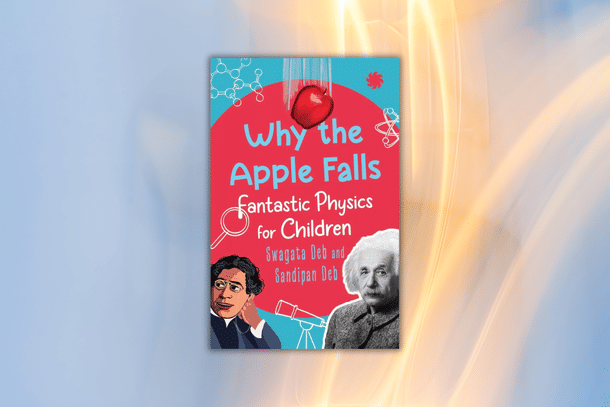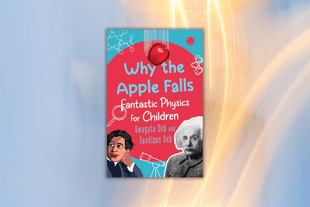Books
'Why The Apple Falls': A Physics Book For All Children
Aravindan Neelakandan
Aug 24, 2024, 05:53 AM | Updated 10:47 AM IST
Save & read from anywhere!
Bookmark stories for easy access on any device or the Swarajya app.


Why the Apple Falls: Fantastic Physics for Children. Swagata Deb and Sandipan Deb. Juggernaut. Pages 328. Rs 350.
As a teenager back in the day, I chanced to buy a book in a school book exhibition — Physics Can Be Fun. Through small experiments and everyday phenomena, the book brought to life the subject that is physics. The illustrations made the understanding easier and attractive. It was authored by Yakov Perelman. It was a fascinating read and an introduction to a new way of looking at the world around you.
Physics is interesting because it is like the Brahman of the spiritually inclined — it encompasses everything.
Structures and functions of all things around us — from why a water droplet looks the way it does to why an apple falls, to why the galaxies are rotating and why the time flies forwards, at least to our experience — physics penetrates everything.
Whatever the fault and crimes of the USSR (the Soviet Union), its existence did provide Indian students with a regular supply of good popular science books. Though, on the flipside, those books were laden with ideology.
But Perelman's book had no such ideological trojans. Even today, after a century, that book is a superb resource for teaching physics in schools.
The spirit of Perelman is conspicuous by its absence in our school curriculums, right or left. So with popular science books often beyond the reach of the average Indian student, India has a great need for good, inspiring popular science writing — particularly aimed at the student community.
This long introduction is necessary because Why Apple Falls: Fantastic Physics for Children is a book that significantly fulfills this need.
Authors Swagata Deb and Sandipan Deb take the young reader on an odyssey through time and the concepts, discoveries, and mysteries of physics.
You meet Aryabhatta and Bhaskara, for instance. The book underscores the importance of Aryabhatta's work with respect to the value of pi. The use of the word ‘āsanna’ in the verse of Aryabhatta, which means approaching and hence approximate, indicates that the Indian mathematical astronomer of the fifth century CE was aware of the notion of the irrational nature of pi.
The authors have also given the value of pi up to 500 places — quite a way to impress and trigger the interest of students.
The book highlights the transformational contribution of Bhaskara-I also. The authors, however, are careful not to give an overdose of the Indic-centric vision, which is definitely in the book in a positive way. They situate the Indian contribution in the context of the global evolution of physics.
Nicolas Copernicus's role in challenging the Earth-centred cosmology and sparking a major revolution in our understanding of the universe is clearly explained, beginning with the observational problems that questioned the belief in our central place in the cosmos.
The reader can also peep into some lesser-known and not so-flattering dimensions of physics, like how the rivalry between Isaac Newton and Robert Hooke, a polymath and a possible ‘British Leonardo da Vinci', eclipsed the latter of his rightful place in science.
As we move into the discovery of electric current, we meet Benjamin Franklin and George Simon Ohm; the latter gave us the famous Ohm’s Law, and the book introduces the young reader to its equation.
Stephen Hawking, in his famous A Brief History of Time, remarked that any equation included in the book would halve the sales per equation. I am sure that is not the case here. I would even suggest including a historical table of physics equations, from Newton's law of gravitation to Albert Einstein's famous E=mc².
The book also takes the young minds into the enchanting realms of quantum mechanics. The children learn about the famous Niels Bohr-Einstein debates as to how quantum mechanics impacts our view of reality.
Here is how the authors provide the essence of the Bohr-Einstein debate for the young minds:
The idea of the particle becomes a real electron only when someone observes it. The act of observation causes its existence. In Bohr’s words, the particles have no ‘independent reality in the ordinary physical sense’. Einstein rejected this theory. An electron is an electron, he said, and it will always be there even if no one is looking at it.Why the Apple Falls: Fantastic Physics for Children (page 156)
And the conclusion of the authors? For now, Bohr seems to have won the debate.
The book also has a chapter on Indian scientists who did and did not win the Nobel prizes.
A young reader, when she finishes the book, can give you a brief account of the Bose-Einstein condensate. More importantly, a child will know physics in its historical context and will be able to see physics in action, in the phenomena she sees around her.
It does not matter if the child is talented in physics or science. This is a book for all children. Whether a child is interested in history or talented in art, the book will enlarge her canvas. That is the most important thing needed now.
It is tough to write a book. It takes a lot of churning and hard work. It is always easy to give suggestions. Yet here are a few. Personally, I would love to have seen hand-drawn illustrations, particularly for concepts, rather than Wiki Commons illustrations. The content of this book deserves an accompaniment of special drawings.
I would also request the authors for a chapter on physics popularisers, like Michio Kaku, Stephen Hawking, and, most important of them all, Richard Feynman.
Our own Jayant Vishnu Narlikar — a great physicist, institution-builder, and a science fiction and popular science writer — needs to be introduced to the young generations. The book only mentions him in a quote about Meghnad Saha.
Aravindan is a contributing editor at Swarajya.





